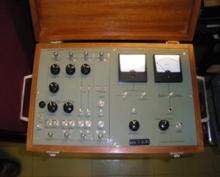A device for measuring the intensity of noise, music, and other sounds. A typical meter consists of a microphone for picking up the sound and converting it into an electrical signal, followed by electronic circuitry for operating on this so that the desired characteristics can be measured. The indicating device is usually a meter calibrated to read the sound level in decibels (dB; a logarithmic unit used to measure the sound intensity). Threshold of hearing is about zero decibels for the average young listener, and threshold of pain (extremely loud sounds) is around 120 decibels, representing a power 1,000,000,000,000 (or 1012) times greater than zero decibels.
The electronic circuitry can be adjusted to read the level of most frequencies in the sound being measured or the intensity of selected bands of frequencies. Because the alternating current (AC) signal received by the unit’s microphone first must be converted to a direct current (DC), a time constant must be incorporated to average the signal. The constant selected depends on the purpose for which the instrument was designed or for which it is being used.
A typical sound-level meter can be switched between a scale that reads sound intensities uniformly for most frequencies—called unweighted—and a scale that introduces a frequency-dependent weighting factor, thus yielding a response more nearly like that of the human ear. A-frequency-weighting is the most commonly used standard, but B-, C-, D-, and Z-frequency-weightings also exist. The A-frequency-weighting scale is useful in describing how complex noises affect people. Thus, the scale is recognized internationally for measurements relating to prevention of deafness from excessive noise in work environments.

